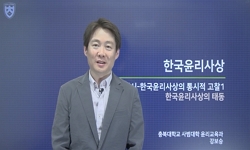The purpose of this paper is to analyse Tasan Jeong Yak-yong's(1762-1836) huti theory(互體論) to examine the reason or necessity and justification for applying huti to the interpretation of the Gua-hsiao-ci(卦爻辭) of the Zhouyi(周易) based on...
http://chineseinput.net/에서 pinyin(병음)방식으로 중국어를 변환할 수 있습니다.
변환된 중국어를 복사하여 사용하시면 됩니다.
- 中文 을 입력하시려면 zhongwen을 입력하시고 space를누르시면됩니다.
- 北京 을 입력하시려면 beijing을 입력하시고 space를 누르시면 됩니다.

茶山 丁若鏞의 호체론 분석을 통해서 본 互體法의 정당성 = A Study of the Justification of the Application of the Huti(互體) Method through the Analysis of the Huti Theory of Tasan Jeong Yak-yong
한글로보기부가정보
다국어 초록 (Multilingual Abstract)
Tasan's four methodological principles are based on his original view that the bagua(八卦), the 64 hexagrams(重卦), wuxiang(物象, the symbolic image of things), guabian(卦變) and hsiaobian(爻變) methods of the Shuo Gua(說卦) arose temporarily during the Fuxi(伏羲) period, The huti theory is a concise expression of the quxiang(取象) theory of the xiang-shu(象數) scholars, and its specific aim is to better grasp the symbolism of the gua-hsiao(卦爻) and uncover its potential meanings.
Tasan argues for the legitimacy of huti from the 64 hexagrams structure itself. He cites as the reason for the occurrence of huti that the six hsiao(六爻) in the zhonggua(重卦) are consecutive, and the six hsiao between the zhonggua are separated from each other, yet connected to each other, so that there is no way to analyse them clearly. This means that huti is inherently latent in the hexagrams(divinatory symbols, 卦象) themselves. In order to understand the meaning of hexagrams and gua-hsiao-ci, one must consider the continuity of the six hsiao, for within a single gua(卦), there are not only the two upper and lower gua(卦), but also various ways of connecting the six hsiao, and huti represents them. Therefore, huti can be said to be the basic concept for interpreting the Zhouyi. This paper has also discussed the main issues in the historical debates over the huti theory, the necessity or importance of huti, and the characteristics, significance and limitations of the fertility huti theory.
The purpose of this paper is to analyse Tasan Jeong Yak-yong's(1762-1836) huti theory(互體論) to examine the reason or necessity and justification for applying huti to the interpretation of the Gua-hsiao-ci(卦爻辭) of the Zhouyi(周易) based on the preface of the Zhouyisijian(周易四箋). The term huti refers to the Zhouyi research methodology and interpretive principles advocated by Tasan: tuiyi(推移, the transition of the Gua), wuxiang(物象, the symbolic image of things), and huti(互體, the piling structure of the Gua), hsiaobian(爻變, the change of Hsiao), the third theory, which also includes the methods of daihu(大互), jianhu(兼互), daohu(倒互), weifu(位伏), panhe(牉合), and lianghuzuokua(兩互作卦).
Tasan's four methodological principles are based on his original view that the bagua(八卦), the 64 hexagrams(重卦), wuxiang(物象, the symbolic image of things), guabian(卦變) and hsiaobian(爻變) methods of the Shuo Gua(說卦) arose temporarily during the Fuxi(伏羲) period, The huti theory is a concise expression of the quxiang(取象) theory of the xiang-shu(象數) scholars, and its specific aim is to better grasp the symbolism of the gua-hsiao(卦爻) and uncover its potential meanings.
Tasan argues for the legitimacy of huti from the 64 hexagrams structure itself. He cites as the reason for the occurrence of huti that the six hsiao(六爻) in the zhonggua(重卦) are consecutive, and the six hsiao between the zhonggua are separated from each other, yet connected to each other, so that there is no way to analyse them clearly. This means that huti is inherently latent in the hexagrams(divinatory symbols, 卦象) themselves. In order to understand the meaning of hexagrams and gua-hsiao-ci, one must consider the continuity of the six hsiao, for within a single gua(卦), there are not only the two upper and lower gua(卦), but also various ways of connecting the six hsiao, and huti represents them. Therefore, huti can be said to be the basic concept for interpreting the Zhouyi. This paper has also discussed the main issues in the historical debates over the huti theory, the necessity or importance of huti, and the characteristics, significance and limitations of the fertility huti theory.
동일학술지(권/호) 다른 논문
-
- (사)율곡학회
- 이종성
- 2025
- KCI등재
-
근대기 청원ㆍ보은지역 함종어씨가의 도학정신 및 현실 대응
- (사)율곡학회
- 김문준
- 2025
- KCI등재
-
기호유학의 여성친화적 철학과 현대사회 갈등 해법(Ⅰ) - 여성 성리학자 임윤지당, 이사주당, 강정일당을 중심으로
- (사)율곡학회
- 이영자
- 2025
- KCI등재
-
관산(管山) 안정회(安貞晦): 잊혀진 노사문인을 찾아서 - 『관산유고(管山遺稿)』를 중심으로
- (사)율곡학회
- 이향준
- 2025
- KCI등재




 KCI
KCI KISS
KISS




